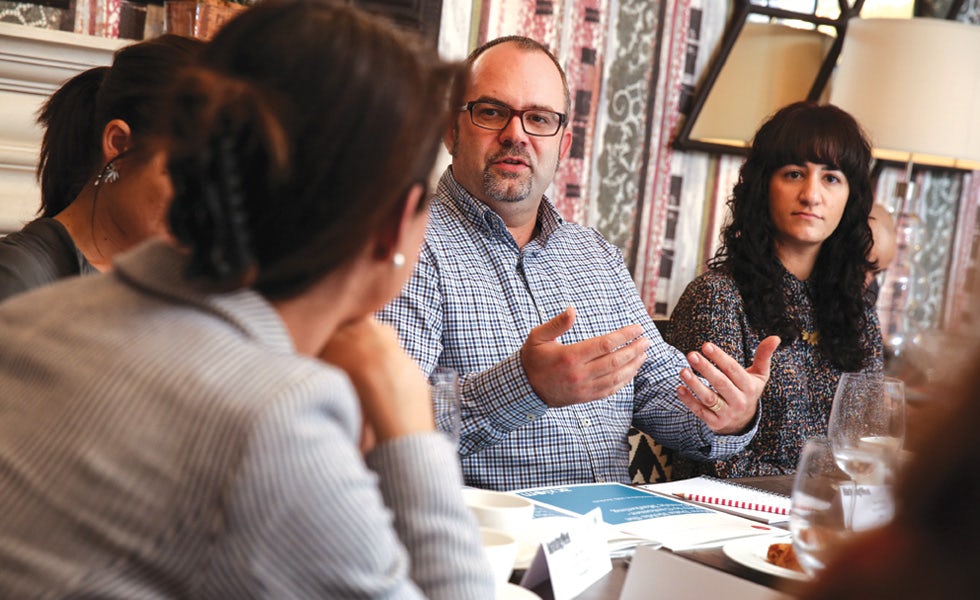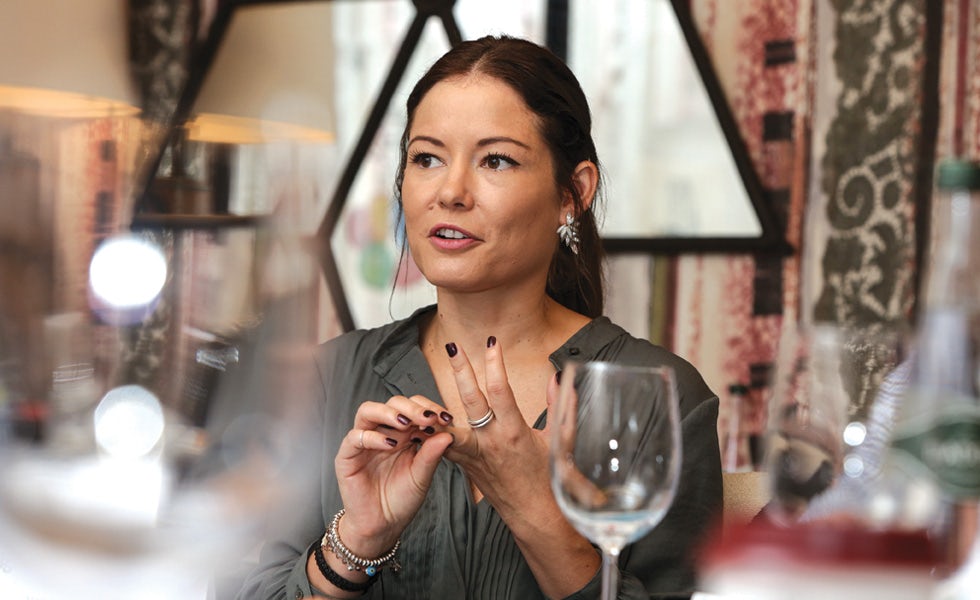Roundtable: Uncover the mysteries of the customer journey
From discovering deeper insight into customer behaviour to tracking across channels and devices to pinpoint the all-important trigger point in consideration, Marketing Week assembled a group of CRM and marketing professionals to shed some light on the customer journey to purchase.


In association with Acxiom
How can you plot your customer journey?
Adam Pow: The Lego customer’s journey is complicated because we have so many channels – from traditional retailers and toy stores to supermarkets and our own retail. One important element is the VIP scheme – our loyalty card – that operates across our own channels delivering loyalty points to the customer and data to track the customer journey. But of course it’s only a part of that journey and we’re exploring how to track outside our channels.
Jade Harris: It’s easier if we look at the Dermalogica web shop or our stores, but that is just 20 outlets compared to our wide network of stockists and independent salons. We’re relying on the owners of each of those to deliver the experience. But we don’t have so much control so it’s about trying to find the most foolproof ways to market to those customers and retain them.
Jema Avedian: It’s important for us to understand the different customers across our brands. Then, one of the biggest parts of our revenue through our site is pre-booked revenue, so we have to adapt the booking process to customer needs and understand their habits.
Ian Landsborough: Being able to track the customer journey depends on the organisation and its make-up – how it goes about acquiring customer data and what incentives it will give. A traditional retailer with a loyalty programme will find it much easier than in the telecoms sector, for example, where distributors and manufacturers aren’t sharing information because of a lack of certainty over who owns the customer.
Jade Harris: A lot of our stockists have had to close their online shops because of the cost of administration and packaging, so we’ve set up our website in a way that takes our stockists with us. If they sign up to be an affiliate they get their own weblink. Using that on social media or web banners when someone clicks through and purchases from us, the affiliate will get 20 per cent of the sale. We’ve also deployed radius locators so if someone purchases directly through our webshop we give a credit to the closest stockist. This means stockists don’t feel threatened by our direct sales and we know that there are customers who just want to buy online.
Is customer type dependent on channel?
Jema Avedian: In the hospitality industry it’s a lot to do with locality. We have to pay close attention to the local market, much more than most other industries. We understand each customer segment using surveys as well as working closely with our bars. They have quite a bit of autonomy in their market. We make sure they’re briefed on a central basis so they communicate messages in the right way.
David Barker: In some industries customer ownership patterns have changed significantly. A few years ago, I’d have described myself as a Vodafone customer with a Nokia phone. Now I’m an Apple customer on O2. It’s a combination of great product and gaining data through linking the customer to iTunes. O2 is trying to turn this around through the Priority Moments scheme to offer benefits beyond calls and data.

How does attributing sales across the multiple channels help your organisation’s view of the customer journey?
Adam Pow: In my previous role at a DIY retailer we were specific about attributing any sale – web or mobile – by looking at the address and attributing the sale to the nearest store. This meant the store had no reason to avoid having the customer transact online so the service provided was better. There was no cannibalising or competing with yourself. It wasn’t perfect as not everyone visits their local store but the insights told us that the majority do.
Jade Harris: We have an online presence because we have to.
Our business model is about supporting skin therapists, driving consumers to a store or salon where the skincare products are prescribed for you. Online is purely a support for customers who prefer it. We try to drive customers from online into salons using bounce-back vouchers, but take-up is low because the type of customer we have online only wants to buy that way.
Ian Landsborough: My main concern is in advertising effectiveness and budget allocation in terms of sales attribution. A lot of organisations attribute the sale down to the last click and that can largely be the result of search engine activity. The consumer can be lazy and rather than type the URL will enter the company name into search and click on the top-ranked result. It doesn’t look at the whole gamut of contribution made by above- and below-the-line marketing. How does an advertising manager spend their budget? The points made about attributing to stores work really well in terms of negating internal conflict.
Jennifer Martin: People have different ways of segmenting the customer journey and prioritising them. We do a lot of research asking guests about everything from menu formats to the posters on the back of toilet doors. We want to give them the information they need, and know when they’d like to be communicated with.
Are you able to use data about your customer and their journey to deliver personalised experiences?
Jema Avedian: We need to understand the right time to target customers for certain occasions. If it’s Friday payday we want to target the female planner on a Monday while she is making her plans for the following weekend. Alternatively, we need to speak to the male after-work drinker on Friday afternoon. We do that through split testing and understanding what appeals to different customers at different times.
Take our recent birthday targeting project – we understand what customer habits are online so we tailored three packages. If they click through to the booking page but don’t fulfil, the tracking system drops it into our call manager system for the contact centre. Then – in a non-creepy way – a trained operative from the bar’s sales team can contact them with a personalised service, based on the fact we know it’s their birthday.
David Barker: Social media allows people to engage directly with a brand and customers do it on a personal basis. The conversations can be quite intimate and customers expect to be interacting with a person, not a machine. They’re expecting personalisation and for you to know and understand them. They expect you to target them and use the data you hold. But there are other segments of the customer base that would not be comfortable if you start being too personal. It’s fascinating the level of data you can learn about customers and build into the customer journey, but that you wouldn’t want to use when talking to them.
Adam Pow: This is an area of huge importance for Lego and one where we’ve progressed a lot in the past few years. We want to tailor our content as much as possible using the data we have. At the moment that is most effective through content on our website that is relevant and based on user behaviour, making it a far more engaging experience. It’s harder in the offline channel but we do have a level of personalisation in the sense that there are different magazines children can subscribe to based on their preferences.
Jade Harris: Two years ago we treated all stockists the same. We’re now trying to look at each account, whether it’s in retail or online, a high street salon or small countryside outlet. We run different promotions with different spend levels to try to motivate our stockists to be active with the brand. Giving stockists the tools to target either the young mum or the teenager with the prescriptive products and make those tools easy to execute is my big challenge.
Jennifer Martin: There’s always more you can do but it has to be right for the guest. What is good for a guest of Revolution or small, independent hospitality company isn’t necessarily right for TGI Friday’s. The company has been around for 50 years and in the UK for 28. It’s like a Bond film: over time it’s been exactly the same story, none of the principles have changed, it’s just how you make them relevant to the audience of the time you’re in. Our audience has to be on board, and it’s the internal audience too.

How do you translate feedback into actionable insights?
Jennifer Martin: We always try to parallel quantitative and qualitative studies. It’s important to have some solid numbers to check general standards. Halloween is a great example. The UK is really on board with this at the moment and it’s great for TGI Friday’s because we’re about making moments special. That said, it’s important that if I’m talking to mums and kids about Halloween and half-term that I’m not also alienating my younger adults. We always trial a concept before we launch it across the estate, but it’s also about taking the time to step back and not look only at individual comments but wider trends too.
David Barker: Sometimes clients will use data at a very personal level to get insight that informs their strategy. Then when they use it they step back and either don’t use it fully or test where a group is engaged and welcomes a more personal approach.
How do you measure success in terms of understanding the customer journey?
Jema Avedian: Social is a big channel for measuring engagement. Ultimately, it’s how many people you can get in the bar but engagement is showing buy-in from the customer that we can benchmark against competitors. We’re starting to use source tracking around each channel and how relevant it is to the customer.
Jade Harris: Online and email conversion rates are easier to track but with our stores and stockists it can only really be about year-on-year sales. We [run promotions at the same times] to deliver targets that become a measure of year-on-year sales.
Jennifer Martin: We look at the usual KPI metrics and investment and see how that performs alongside how we communicate with the right customer demographics. But ultimately, that translates into the atmosphere in our bars and you’ll find that really successful communications and segmentation drive great atmosphere at the times of day you want to focus on.
We haven’t done a huge amount of email marketing, for example, but we’re having ours opened well over the industry standard rate and yet there’s no mention of price or offers. The open rates are all coming from people who just want to hear about what’s happening, and that’s hugely encouraging.
Adam Pow: Lego Club is focused on consumer satisfaction and engagement, and using net promoter score (NPS) has been a phenomenal success. Empirical evidence shows that companies with a high NPS have long-term profitable growth. It’s used extensively throughout Lego and it’s super-easy to understand.
Ian Landsborough: The key is relevance. As long as you’ve got that you’re heading down the path to success. Knowing who your customer is and understanding their preferences and their wider relationships are the foundations of that.
Jennifer Martin: The trap is becoming complacent that you know what those things are. You have to keep stepping back and asking questions about relevant communication channels because everything can change so quickly.

What are the examples to follow or avoid in learning how to manage the customer journey?
Jennifer Martin: Given the nature of its business Amazon is naturally going to be ahead of the curve and I’m sure it can segment to the nth degree with the fantastic data it has. I’d love to have that amount of transactional data. We need to get better not only at capturing data, but capturing it in the right way.
Adam Pow: Amazon is a single channel with the perfect single customer view. When you have fragmented channels it’s much more difficult to do.
Jema Avedian: Tesco is clearly impressive in that it’s specific on product and customer preferences, and can really drill down into what is bought every week. I don’t know if anyone else is doing it as well through online and DM channels.
Jennifer Martin: It’s also good at switching you into other channels that you might not have used from Tesco, such as car insurance and credit cards. The diversification of that business is impressive.
“I don’t think customers realise the whole infrastructure needed to deliver a personalised experience like Amazon’s”
Adam Pow, Lego
Adam Pow: I don’t think customers realise the whole infrastructure needed to deliver a personalised experience like that found on Amazon, but it doesn’t matter. If it’s what they expect and want, it’s what we have to deliver.
Ian Landsborough: There is a retailer on the high street that gives fantastic offers but the way it deploys them is not joined-up. You can go in-store, make a purchase and receive a voucher for 20 per cent off next time. So of course you take the item back only to re-buy it at 20 per cent off. Then you get home to find a follow-up email offering you a further 10 per cent discount.
It damages the brand because the customer feels their time is wasted, the price is perceived as inflated and concerns grow that the company is struggling for sales overall.
David Barker: The final discount email is then also the channel the sale is attributed to and the discounting is deemed a success, despite the fact that most customers would have bought the product anyway.
What will be your next challenge?
Adam Pow: Predicting the future. Technology is moving so fast we almost need a section in our strategy document that is left blank for ‘things that might happen’.
David Barker: But staying true to the core of Lego – isn’t it about playing with things?
Adam Pow: Exactly. In the early 2000s we stopped concentrating on the core play experience and the company started to do badly. We’ve turned it around by focusing on what we do well and doing it properly. And, of course, putting the customer at the heart of everything we do. Understand your customer as much as you can. Spend time with them, find out how they behave. That’s super-rich insight. Yes, you’ll have to match it back to the quantitative data, but you’ll get a strong feeling for what is the right thing to do.






